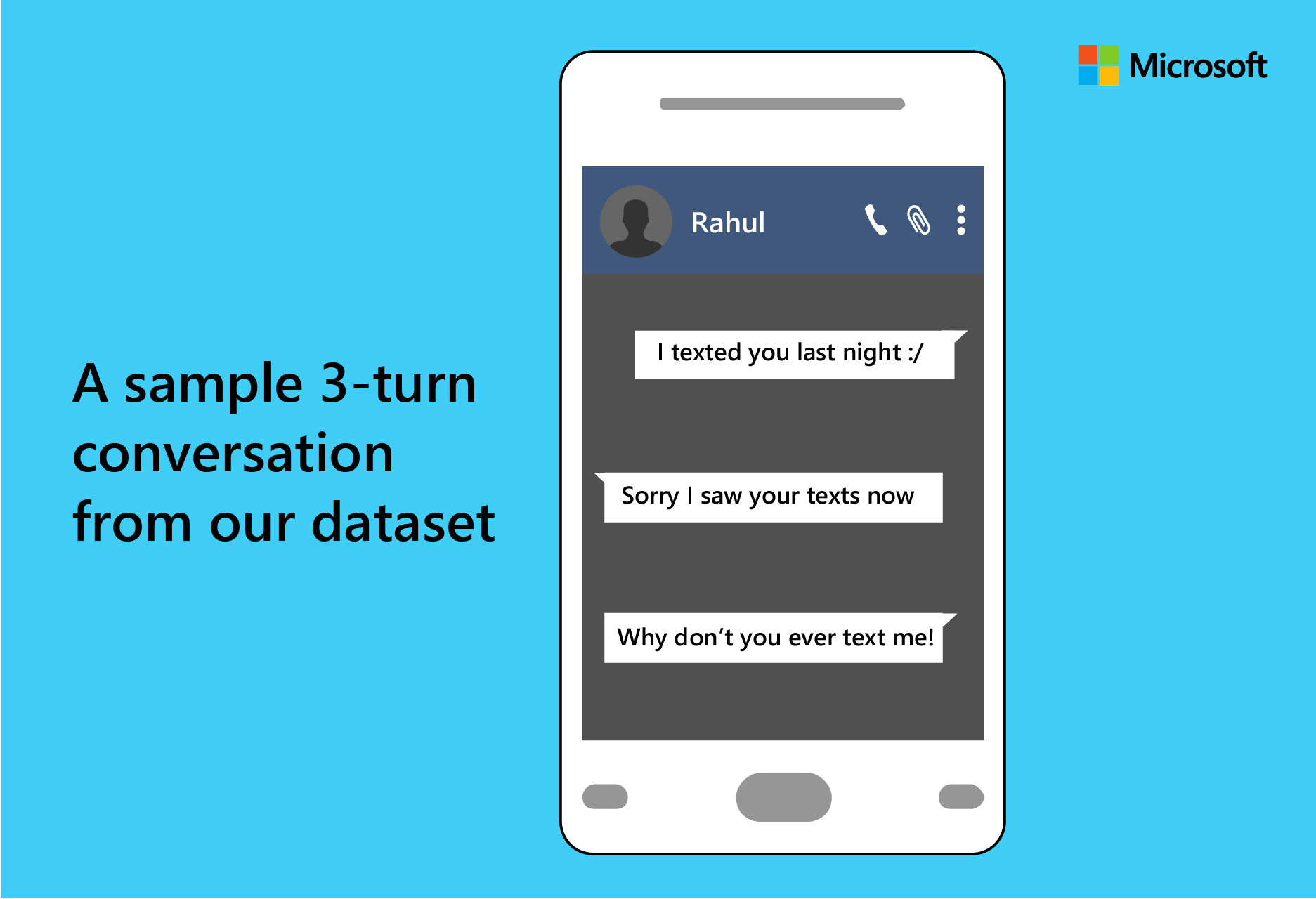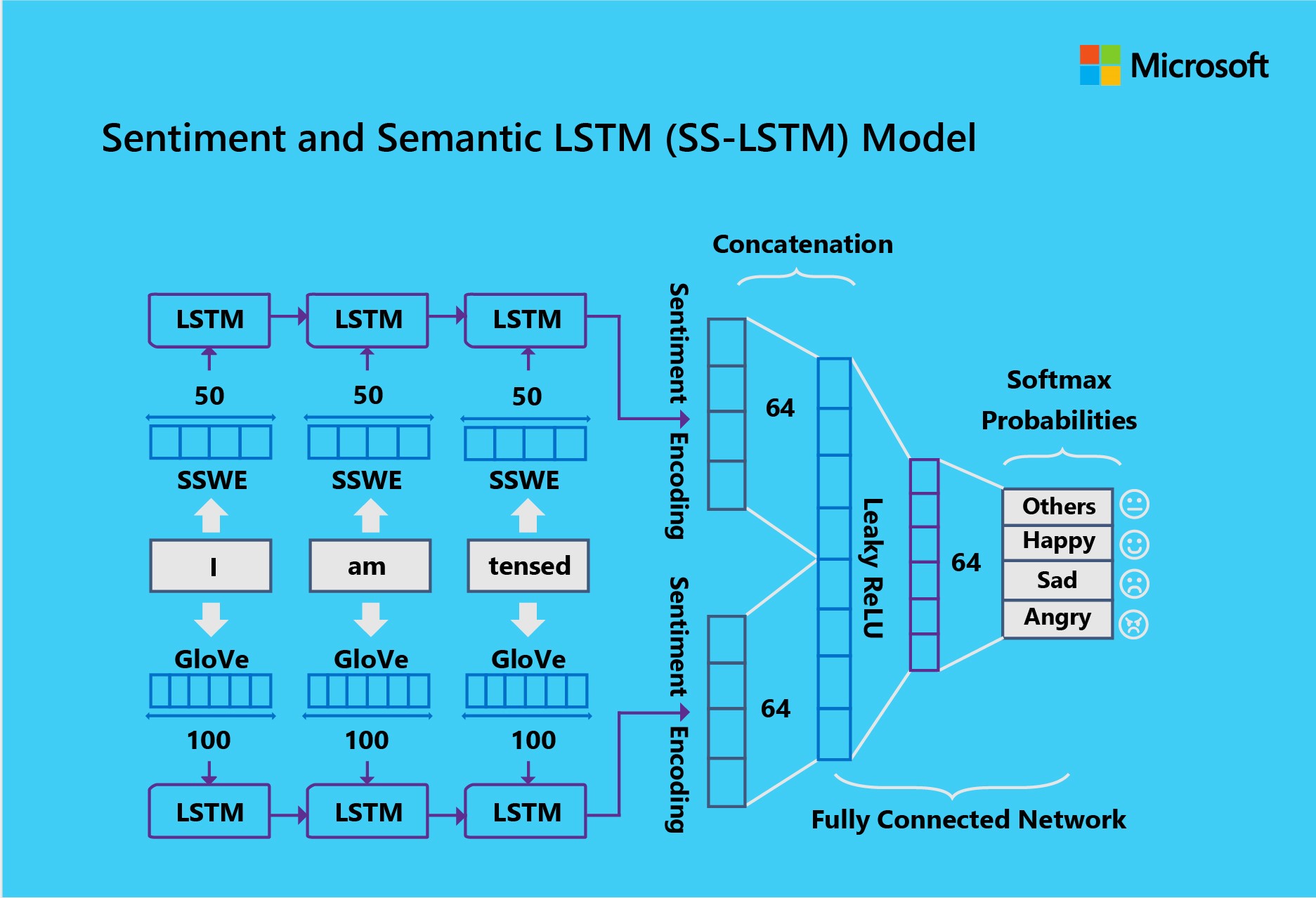Humanizing Artificial Intelligence (AI) with Deep Learning
Emotions run deep in every conversation we humans have. Deciphering these underlying emotions is the key to making machine interactions more human. Detecting emotions in text is difficult enough for human beings, let alone artificially created machines, as many of our emotions are conveyed through expressions and tone of voice.
At Microsoft, we are working to create human-like AI, Ruuh and on this journey detecting user emotions is a critical piece. So, I teamed up with Microsoft researchers Umang Gupta and Radhakrishnan Srikanth to take on this challenge. Also, Ankush Chatterjee, an intern from IIT Kharagpur, joined us taking on his first machine learning research assignment!
Here’s a look at how we arrived at a novel approach to detect emotions in textual conversations:
The challenge of creating emotional Artificial Intelligence (AI)
Detecting emotions accurately is always a challenge, even for human beings. Participants in a conversation often misinterpret the emotion the other person is trying to convey. This is because emotional expressions are often subtle. A slight raising of the eyebrow or a quick smirk can be easily missed. Similarly, a sudden shift in tone is often hard to detect.
Although these gestures are subtle and easy to miss, they carry a wealth of information that can add context to the conversation. Detecting anger or sadness, for example, can help a human being respond appropriately to each interaction. Infusing this skill in machines can help create more useful and empathetic digital agents in the future. A machine that can detect emotions can generate responses that genuinely help users seeking assistance or information.
Machines are already detecting emotions in voice recordings and facial portraits. However, humans today, increasingly communicate using messaging applications. Their interactions through these applications are text-based. Popular social applications such as Whatsapp and Twitter encourage communication through short text messages. Without adequate context and additional information, machines can struggle to detect emotions in such conversations. For example, on reading “Why don't you ever text me!" you may either interpret it as a sad or angry emotion. The same ambiguity exists for machines. Lack of facial expressions and voice modulations make detecting emotions from text a challenging problem.
Moreover, as digital agents gain popularity in our society, it is essential that these agents are emotion-aware and respond accordingly. To solve this problem, we deployed a deep learning algorithm.
Training wheels for AI
High-quality and high-volume data combined with appropriate labels is essential when solving a machine learning problem like this. The team decided to gather data in the form of Tweets sent out between 2012 and 2015. Of the hundreds of millions of tweets collected in this process, 300 were individually labelled by human judges.

Working with snippets of 3-turn conversations, we labelled each under one of four categories: Happy, Sad, Angry or Others. The human judges used textual cues, smileys, emoticons, and punctuation as clues to detect emotions throughout the set. For example, an exclamation mark after a word could often convey anger (‘why!’). Similarly, a smiley or emoticon such as ‘:)’ could convey happiness. Often verbal cues can also indicate an emotion. For example, if a person responds to a text with “there, there,” it could convey a need to comfort someone which may indicate a sadness or despair in the previous text.
Once the human judges pruned this relatively small dataset, a nearest neighbour based clustering algorithm was used to automatically sort the larger set into respective categories. The team finally obtained 456K utterances in the Others category, 28K for Happy, 34K for Sad, and 36K for Angry.
Massive data and appropriate labelling acted as the two training wheels for our Machine Learning solution for emotion detection. We called our solution ‘Sentiment and Semantic Long Short-Term Memory (SS-LSTM) Model’ .

As the name suggests, this Deep Learning model combines semantics and sentiment indicators to categorize text conversations based on the emotions they convey. To train the model, we used the Microsoft Cognitive Toolkit and divided the data into ‘training’ and ‘validation’, based on a ratio of 9:1 (9 sets for training and 1 set for validation). We discovered that the optimal batch size for training the model was 4000 . With this batch size the learning rate of 0.005 gave us best results.
Finally, the team decided to test the model and compare its predictive power against other techniques. 2,226 3-turn conversations from 2016 were picked from Twitter to test the model.
The results
For each of the four emotion classes, our SS-LSTM model outperformed all other known state of art techniques for detecting emotions in textual conversations. The model performed better than individual LSTM-SSWE (Sentiment Specific Word Embedding) and LSTM-GloVe. SS-LSTM was also significantly better than Convolutional Neural Network (CNN) based approaches. Also, our Deep Learning based approach was found to be better than traditional Machine Learning techniques like Naïve Bayes, Support Vector Machines and Gradient Based Decision Trees.
The key difference was the model’s ability to detect emotions by combining semantics and sentiment indicators. In other words, the model simply ‘understood’ the conversation on a deeper level than other models.
Final thoughts
Conversations online are mostly in the form of short text messages. Without the benefit of voice modulation or facial expressions, detecting the emotion in conversations can be difficult. Despite the challenge, creating a digital agent that can detect emotions could be incredibly useful. Digital agents of the future may be a lot more capable if they can empathize with their users’ feelings and respond appropriately. They could provide emotional support, contextual information, and even generate responses that suit the mood of the conversation.
By creating a model that combines semantics and sentiment indicators in short, text-based conversations, our team has helped take a significant leap forward in detecting emotions. The job is not done, but we’re committed to keep chipping at it one bit at a time!